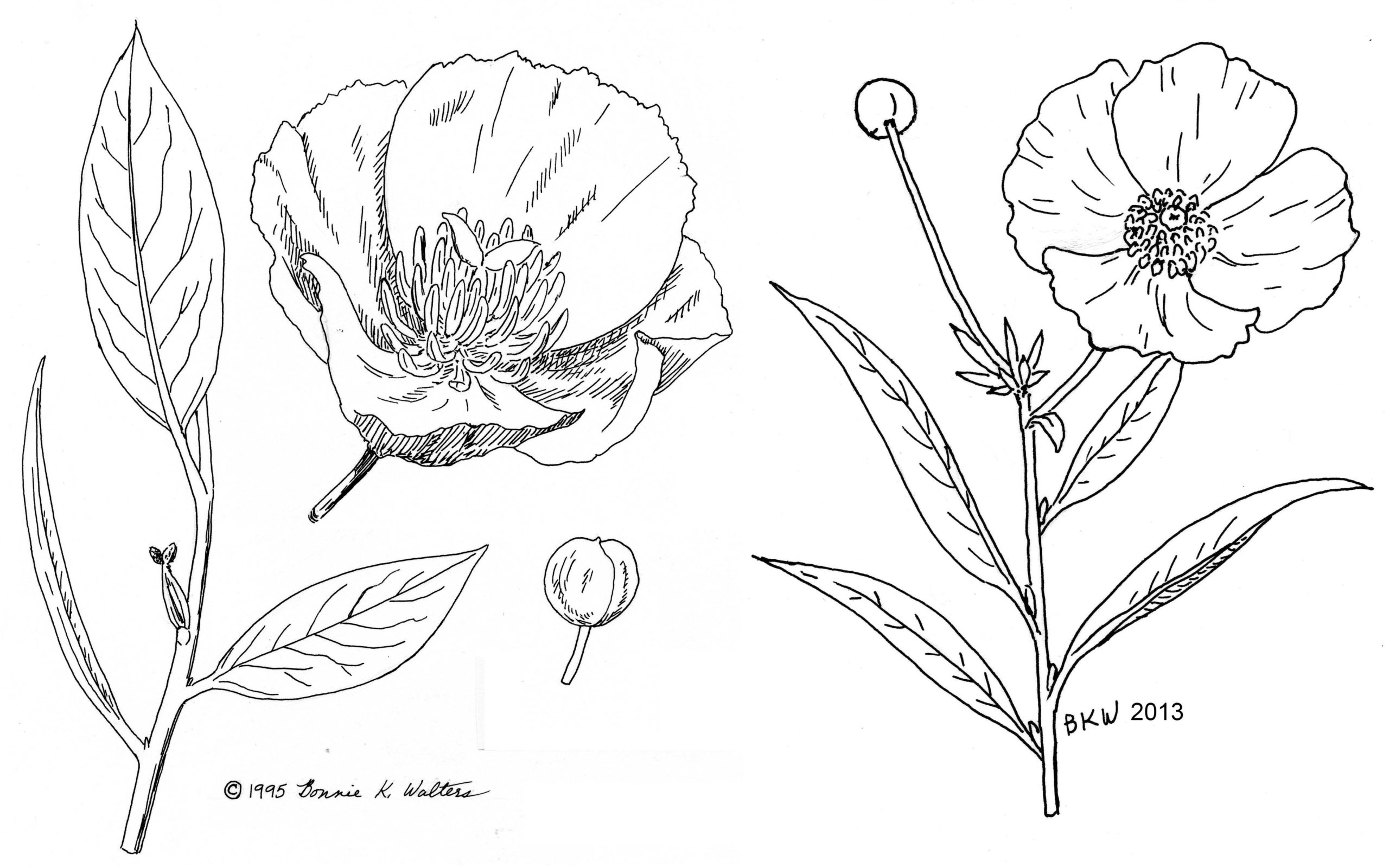Bush Poppy
A funny thing happened while Bonnie and I were working on the drawing and article for and about the plant discussed in this issue of Obispoensis. Before we started, we consulted Dirk’s list of past drawings and could not find any entry for Bush Poppy, a.k.a., Tree Poppy, (Dendromecon rigida). But after Bonnie was well into the drawing and I had started the article, we discovered a drawing and article from April 1995. We decided to go ahead and complete the ‘new’ drawing and possibly update what was said about Dendromecon back in 1995.
Bush poppy is one of the more common and easily recognized of our local shrubs. It is a woody member of the poppy family (Papaveraceae) and is especially common in our scrub communities (chaparral & coastal scrub) after fires. I’ve observed scores if not hundreds of plants per acre the first year after a fire. However, as the community matures, bush poppies begin to die out and become restricted to disturbed areas such as road cuts and trail edges. It is for this reason as well as its large conspicuous yellow flowers that this species actually appears to be more common than it actually is.
The poppy family is characterized by sepals being shed when the four petals expand (caduceus). Note that the spherical structures in Bonnie’s drawings are flower buds and not fruits. The superior ovary is long and thin. There are two very short styles which end in two large, flat stigmas. These can be seen in the drawing of the flower as well as the small aborting fruit found among the leaves in the 1995 drawing.
The ovary contains many seeds which are attached to two areas on opposite sides of a single cavity (i.e., parietal placentation). Each small seed contains a small fleshy body near the attachment of the stalk (funiculus) attaching it to the ovary/fruit wall. In the process of the capsule explosively splitting from the bottom up, the seeds are thrown away from the plant. After the seeds land on the ground, ants collect the attached fleshy body (aril) and carry them back to their nests. When the ants arrive back at the nest they either remove the seed from the aril before taking the aril into the nest or later. If the seed is removed later, it is taken out of the nest and thrown into the ant colony’s refuse heap. Either way, ants are very important in seed dispersal of this poppy.
Our local species is Dendromecon rigida which is common throughout most of the southern California mainland extending in to northern Mexico. A second species that is very similar to D. rigida is found naturally restricted to a few of the Channel Islands. This is D. hartfordii or the Channel Island tree poppy. This rare species differs from the more common mainland tree poppy by having larger flowers and shorter, fatter leaves. Lastly, the mainland tree poppy has minutely toothed leaf margins where as the island form has completely smooth margins. It appears that I may have misidentified the species in Bonnie’s 1995 drawing as the twig in the drawing as its leaves are drawn shorter and wider than her current drawing which is based on local SLO County plants.
One might expect that a plant with such large and showy flowers would have a significant following among California native plant aficionados. Also, we would expect the island bush poppy to be the preferred species as it has larger flowers, and this is often the case. However, Dendromecon is not commonly found in the home garden because it is particularly devilishly hard to get started. According to internet entries as well as Bornstein, Fross and O’Brien’s California Native Plants for the Garden (2005), its roots are especially sensitive to disturbance. According to Dara E. Emery’s book, Seed Propagation of Native California Plants, growing it from seed requires either a fire treatment or stratification (buried in between layers of moist sand) for 1½ months with a daily temperature fluctuation of between 46oF and 70oF. Mr. Emery indicates they can be more easily propagated by winter cuttings placed in a propagation bench supplied with intermittent mist and bottom heat. If you do try to propagate this species or especially if you buy potted ones, remember to treat their roots with extreme caution. Plant the root ball with little or better NO disturbance.



We are CNPS San Diego and would like to find out if Bonnie Walters will allow us to use her native plant illustrations in our native garden tour guide for our upcoming tour. I can be reached below:
Christine Hoey, Co-director
CNPS-SD Native Garden Tour